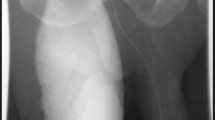Summary
Background
Bladder hernias are relatively rare condition while only accounts for 1–4 % of inguinal hernias. It is not the surgery but the diagnosis that remain the major challenges of clinical practice.
Methods
Herein, we report five cases of bladder hernias with different clinical presentation, and review of current literature.
Results
The definite diagnosis relies on clinical suspicion and multiple urographic imaging. Sonography is a preferred image modality for its inexpensive and noninvasive nature. Abdominal computed tomography (CT) could depict the anatomic details of the hernia lesion and its relationship with the surrounding pelvic organs. Although bladder herniation is not a malignant condition, it can be fatal due to iatrogenic surgical complications.
Conclusions
In addition to current indications, refractory urinary tract infection should be viewed as another indication of partial cystectomy. Besides, repeated urography should be considered as the tool to ensure the result of surgery.




Similar content being viewed by others
References
Server Pastor G, Lopez Cubillana P, Hita Villaplana G, Prieto Gonzalez A, Hita Rosino E, Server Falgas G. Inguinal bladder hernia. Report of 4 cases. Actas urologicas espanolas. 1994;18:670–3.
Kraft KH, Sweeney S, Fink AS, Ritenour CW, Issa MM. Inguinoscrotal bladder hernias: report of a series and review of the literature. Can Urol Assoc J [Journal de l’Association des urologues du Canada]. 2008;2:619–23.
Izes BA, Larsen CR, Izes JK, Malone MJ. Computerized tomographic appearance of hernias of the bladder. J Urol. 1993;149:1002–5.
Levine B. Scrotal cystocele. J Am Med Assoc. 1951 Dec 8;147:1439–41.
Wagner AA, Arcand P, Bamberger MH. Acute renal failure resulting from huge inguinal bladder hernia. Urology. 2004;64:156–7.
Casas JD, Mariscal A, Barluenga E. Scrotal cystocele: US and CT findings in two cases. Comput Med Imaging Graph. 1998;22:53–6.
Bacigalupo LE, Bertolotto M, Barbiera F, et al. Imaging of urinary bladder hernias. AJR Am J Roentgenol. 2005;184:546–51.
Oruc MT, Akbulut Z, Ozozan O, Coskun F. Urological findings in inguinal hernias: a case report and review of the literature. Hernia. 2004;8:76–9.
Catalano O. US evaluation of inguinoscrotal bladder hernias: report of three cases. Clin Imaging. 1997;21:126–8.
Karaman ZC, Saray A, Dorak C, Tamac NI. Ultrasonographic diagnosis of massive bladder hernia. J Clin Ultrasound. 1993;21:534–6.
Verbeeck N, Larrousse C, Lamy S. Diagnosis of inguinal bladder hernias: the current role of sonography. JBR-BTR. 2005;88:233–6.
Andac N, Baltacioglu F, Tuney D, Cimsit NC, Ekinci G, Biren T. Inguinoscrotal bladder herniation: is CT a useful tool in diagnosis? Clin Imaging. 2002;26:347–8.
Pasquale MD, Shabahang M, Evans SR. Obstructive uropathy secondary to massive inguinoscrotal bladder herniation. J Urol. 1993;150:1906–8.
Thompson JE, Jr, Taylor JB, Nazarian N, Bennion RS. Massive inguinal scrotal bladder hernias: a review of the literature with 2 new cases. J Urol. 1986;136:1299–301.
Colodny AH. Bladder injury during herniorrhaphy. Manifested by ascites and azotemia. Urology. 1974;3:89–90.
Novaretti JP, Silva RD, Cotrim CA, Souto LR. Migration mesh mimicking bladder malignancy after open inguinal hernia repair. Hernia. 2012;16:467–70.
Bjurlin MA, Berger AD. Herniorrhaphy mesh as nidus for bladder calculi. Urology. 2011;78:329–30.
Panagiotakis GI, Spyridakis KG, Chatziioannou MN, Kontopodis NG, Kandylakis SE. Repair of an inguinoscrotal hernia containing the urinary bladder: a case report. J Med Case Reports. 2012;6:90.
Regis L, Lozano F, Planas J, Morote J. Bladder cancer in an inguinoscrotal vesical hernia. Case Rep Oncol Med. 2012;2012:142351.
Pastor Navarro H, Martinez Ruiz J, Carrion Lopez P, et al. Tumor inside an inguinoscrotal bladder hernia. Arch Esp Urol. 2010;63:471–6.
Acknowledgements
The authors also like to thank those who gave the valuable suggestions that contributed to the work of this manuscript.
Conflict of interest
The authors declare that there is no conflict of interest in relation to this article.
Author information
Authors and Affiliations
Corresponding author
Rights and permissions
About this article
Cite this article
Lee, TH., Huang, CN., Huang, SP. et al. Inguinoscrotal herniation of bladder: case series and literature review. Eur Surg 46, 74–78 (2014). https://doi.org/10.1007/s10353-014-0251-2
Received:
Accepted:
Published:
Issue Date:
DOI: https://doi.org/10.1007/s10353-014-0251-2




